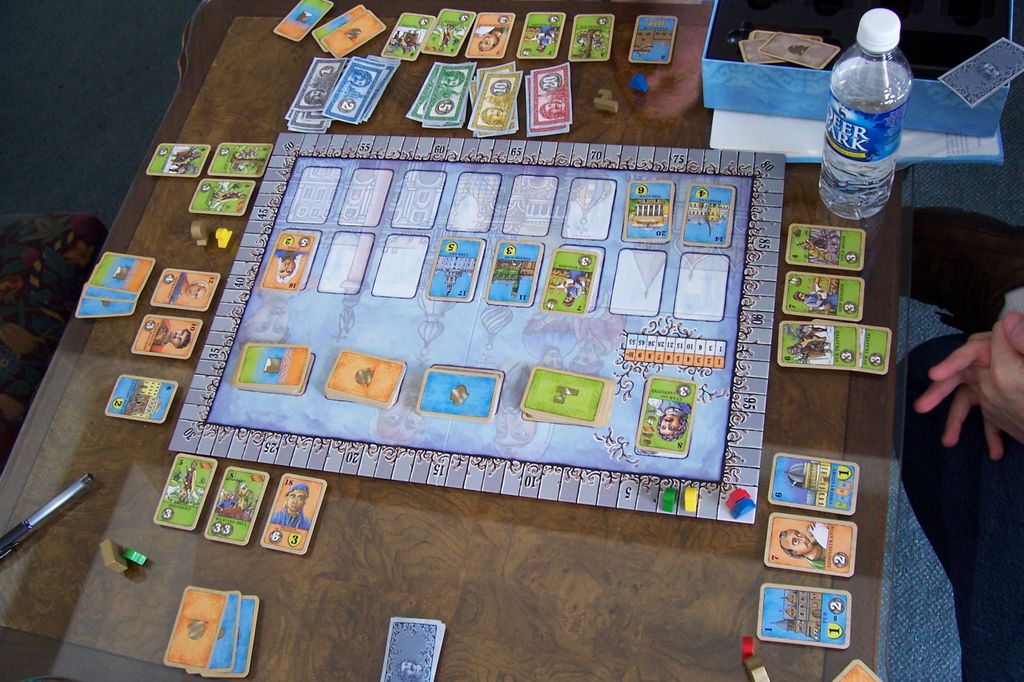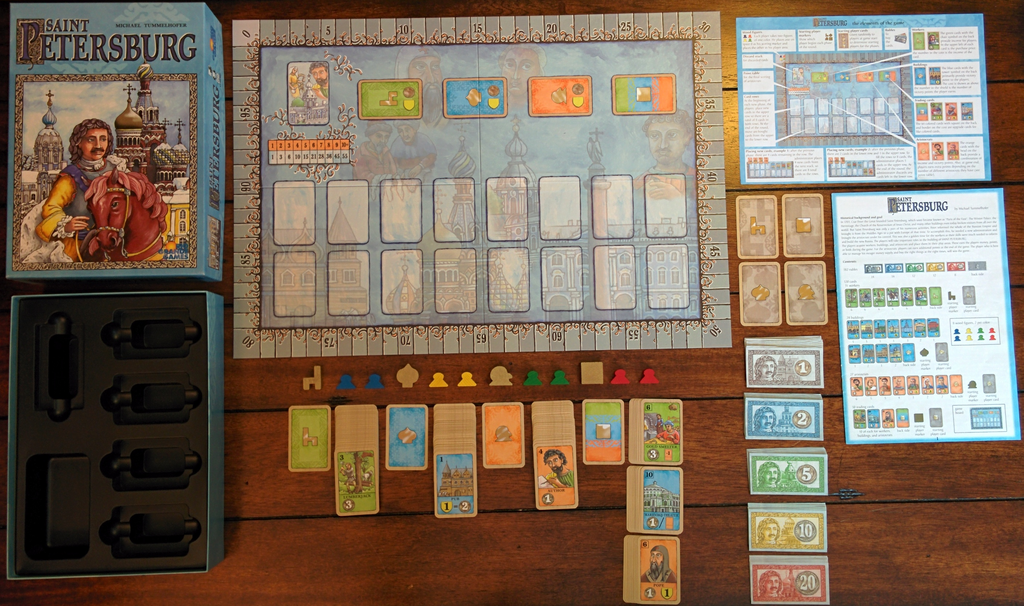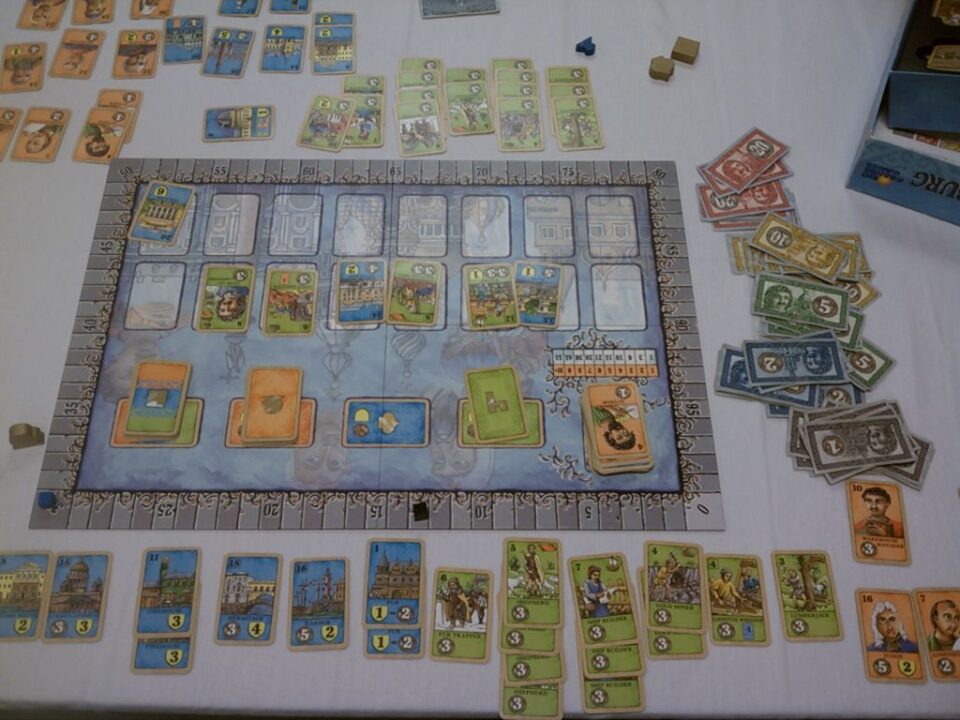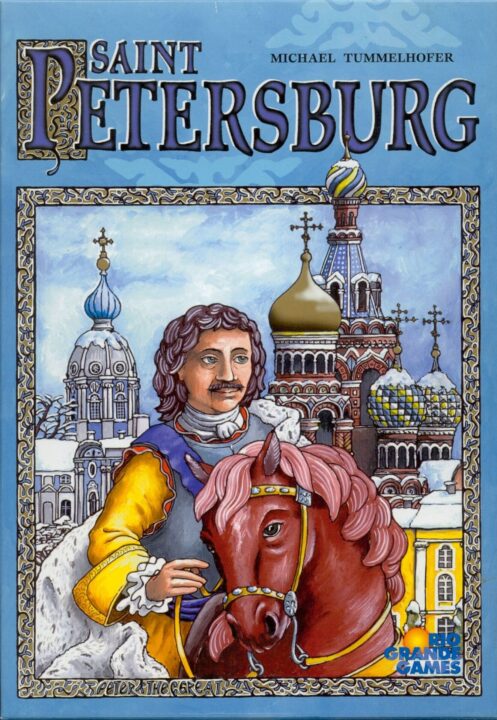Overview
Welcome to our review of the illustrious Saint Petersburg – a strategic treasure where mastering the art of resource management, engaging in subtle yet significant player interaction, and navigating the clever game round progression are keys to building your economic empire. It’s no wonder that with every play, memories are minted and friendships are forged—it draws yet another round of hearty laughter, groans at missed opportunities and the earnest desire to perfect your strategies with every fresh deal of the cards. Navigate through this review as we break down the key aspects of the gameplay and exactly why Saint Petersburg earns a place at the game night table!
How It Plays
Setting Up
Saint Petersburg kicks off with a straightforward set up: each player receives a starting amount of money and some initial workers. A row of cards is then laid out for the first round, depicting workers, buildings, aristocrats, and more, all waiting to be snapped up.
Gameplay
Players take turns purchasing cards from the central tableau, employing strategy to craft their versions of the most efficient engine. Deciding what to buy and when isn’t just about saving your rubles; it’s about planning for future rounds and predicting what your opponents might do.
Winning the Game
The game ends after a predetermined number of rounds, and victory points dictate the winner. Accumulate points through savvy acquisitions and by building a deck that not only generates wealth but maintains a melting pot of aristocrats, buildings, and all-important upgrades. It’s an elegant dance of accumulation and refinement leading to triumph or defeat.
Want to know more? Read our extensive strategy guide for Saint Petersburg.
Mastering Resources like a Tsar
Resource Allocation Savvy
While hosting a recent Game Night – themed ‘A Night in Saint Petersburg’ – we cracked open the old favorite. Our focus was razor-sharp on a crucial aspect I’d dabble into in this Saint Petersburg Review: strategic resource management. As you begin, the tension is palpable, each of us vying for those critical resources that spur our city’s growth. Often, I’d strategically postpone building, a tantalizing dance with risk, guaranteeing resources for a pivotal future round. Transitioning adeptly between scarcity and surplus defines the Saint Petersburg experience.
Ingenious Drafting Mechanics
Admittedly, I’ve reveled in the art of drafting here – carefully choosing which cards to pass along significantly cuts off opponents’ strategies. This isn’t just about resource management; it’s a delicate balance of projection and adaptability. Reading the table, anticipating their moves, redirecting mine, and weaved seamlessly within it all – sound card-based strategy. Those decisions resonate deeply with in-game success and were often a core discussion in our post-game analysis huddles.
Now, let’s shuffle the deck and delve into the nuanced world of Player interaction dynamics.

The Heart of the Game: Interactive Play
In my gaming circle, one of the most delightful experiences provided by Saint Petersburg has to be its player dynamics. Moreover, it’s a testament to a game’s design when you remember the interactions as much as the outcome, and Saint Petersburg definitely shines here. Let’s delve into this vital component.
Competitive Cooperation
During one memorable session of Saint Petersburg, the tension was palpable as we danced around each other, vying for the most valuable workers. This is resource interaction at its finest; you want players to ‘cooperate’ by leaving you what you earnestly need, but there’s a competitive twist—each decision impacts the other contenders. Initially, everyone is congenial, aiming for a functional engine, but the choices soon become deliciously confrontational as scarcity rears its head. Suddenly, you’re not just playing the market; you’re playing the people.
The Social Stratum
Then there’s the social ladder of the game world itself. I recall endgame standings swaying during a final, ambitious turn when a friend surprised us all—a quiet contender seizing prestigious buildings, altering status dramatically. In these moments, Saint Petersburg particularly distinguishes itself not merely as an exercise in economics but as a sandbox of subtle social duels. These engagements aren’t loud or flashy; instead, they weave an undercurrent of strategy that keeps each player attentively entwined in the collective narrative.
What begins as a seemingly mild-mannered economic simulation escalates, by virtue of player interaction, into an intricate tableau of alliances and feints. Player dynamics in Saint Petersburg are the hidden levers that can uplift a novice to mastery—and potentially, to victory. Now, in anticipation of such shrewd maneuverings, one ought to consider the significance of the strategic rhythm in game round progression.

The Rhythmic Dance of Strategy: Saint Petersburg’s Round Progression
Within the analgesic symmetry of ‘Saint Petersburg’, one experiences the game’s soul—its round progression. Like clockwork, every move and choice feeds into the next, producing an intricate ballet where foresight is your most loyal companion. Remember the first time I shuffled and dealt those cards? The air was thick with anticipation, a look shared among friends, acknowledging the tacit contest of wits that lay ahead.
Rounds Shaping Strategies
Often, while analyzing the pattern of play for my ‘Saint Petersburg Review’, it’s startling to remark how each round’s closure sews the inception of the next. The poise needed to align one’s tactics with the fluidity of the game is engaging. Enthralling friends, who usually anticipate my downfall, would nudge under the table as a worker card slipped into my growing tableau, subtly altering the game’s momentum.
Layers Upon Layers
The enthralment deepens as layers unfurl. Playing wave after wave, phase unto phase, I’m always nudging boundaries, being tantalized by possibilities—a growing crescendo of intrigue and interaction. And similarly, Saint Petersburg marvelously crescendos through money, building, aristocrat, and exchange cards, each molding the stature of your Russian empire. True to form, just as the theoretical physicist shapes the cosmos with numbers, we, as players, shape destinies here through rounds.
And so, would I recommend ‘Saint Petersburg’? Infinitely, yes. Each round leaves you cognitively richer and more socially intertwined—emblematic reasons for my perpetual revisit to the gilded streets of this board game classic.

Conclusion
Concluding this Saint Petersburg review, after delving suitably deep into the intricacies of strategic resource manipulation, the excitement of player-to-player dynamics, and the pivotal rounds that keep the engine ticking – I can audaciously say the beauty of this game lies beyond its illustrations. While artwork may whisk a fleeting glance, the game’s refined mechanics garner devoted attention. Saint Petersburg executes a delicate balance between player interaction and strategic planning, which is no small feat in board game design. It’s a rich tapestry of cunning and calculated moves that stitches together an experience both casual and hardcore gamers can confidently get wrapped up in. Would I recommend setting up shop in this vibrant game of trade? Most assuredly, I would say it’s a resounding ‘da’ from this strategy aficionado.


